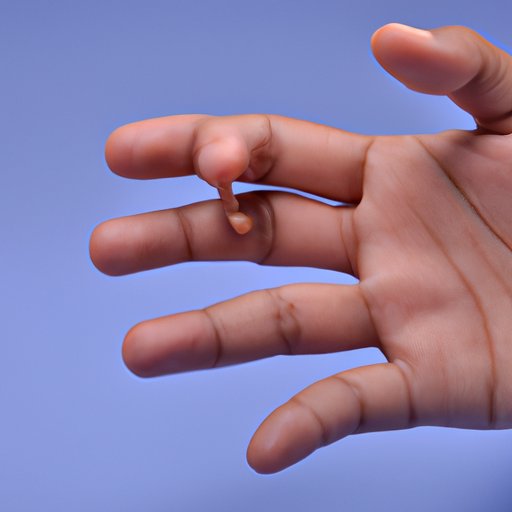Introduction
Have you ever experienced sore, aching fingertips? Fingertip pain is a common issue that affects people of all ages, and it can be caused by various factors. In this article, we will explore the causes of fingertip pain, recognize the symptoms, and provide some feasible solutions to alleviate and prevent the discomfort.
Causes of Pain in Fingertips: Exploring the Different Factors That Can Lead to It
Fingertip pain can occur due to many different reasons, including cold weather, poor circulation, arthritis, and nerve damage. Cold weather can cause a decrease in blood flow to the fingertips, leading to numbness and tingling sensations. Poor circulation, a common issue in older adults or those with underlying health conditions, can also cause fingertip pain by reducing the delivery of oxygen and nutrients to the fingers. Arthritis, another prevalent factor, can cause inflammation and stiffness in the joints of the fingers, leading to pain and discomfort. Lastly, nerve damage, often caused by injuries or underlying medical problems such as diabetes, can cause a range of symptoms, including pain, tingling, and numbness.
10 Possible Reasons Why Your Fingertips Hurt: Recognizing the Symptoms and Solutions
The following are ten causes of fingertip pain and their corresponding symptoms and solutions:
1. Frostbite – numbness, stinging, and a prickly feeling in fingers and parts of the body that are exposed to the cold. Treatment includes gradually warming the affected area and seeking medical attention if symptoms persist.
2. Raynaud’s Disease – pain, numbness, and color changes in the fingers and toes under chilly conditions or stress. Treatment includes avoiding triggers and taking prescribed medications.
3. Carpal Tunnel Syndrome – a throbbing, burning pain in the fingers and wrists, often resulting from repetitive hand motions. Treatment includes resting the affected hand and wrist, using wrist splints, and undergoing surgery if necessary.
4. Trigger finger – difficulty straightening or bending fingers, pain, and clicking or popping sounds in the finger joints. Treatment includes resting the affected finger, taking pain medication, and undergoing surgery in severe cases.
5. Tendinitis – pain, swelling, and tenderness in fingers and other joints resulting from inflammation of tendons. Treatment includes resting the affected finger, applying cold compresses, and taking medication to relieve pain and inflammation.
6. Dupuytren’s Contracture – thickening and tightening of hand tissue fibers, causing fingers to curve inward. Treatment includes undergoing surgery or using a special device to stretch out the fingers.
7. Osteoarthritis – pain, stiffness, and swelling in finger joints resulting from worn cartilage and bone spurs. Treatment includes taking anti-inflammatory drugs, doing physical therapy exercises, and using heat or cold therapy.
8. Gout – sudden and intense pain, redness, and swelling in the joints, including the fingers. Treatment includes taking medication to alleviate pain and reduce inflammation, as well as making lifestyle changes to prevent gout attacks.
9. Peripheral neuropathy – pain, tingling, and numbness in the feet and hands, resulting from nerve damage. Treatment includes managing underlying medical conditions and taking medications to alleviate pain.
10. De Quervain’s Tenosynovitis – swelling, pain, and tenderness from overuse of muscles and tendons in the wrist and thumb. Treatment includes resting the affected hand, wearing a splint or brace, and taking medication to manage pain and inflammation.
Why Typing All Day Can Take a Toll on Your Fingertips: Tips for Office Workers
Repetitive typing can aggravate wrist and finger joints, leading to pain and inflammation. Office workers who type for long hours every day should take precautions to prevent or alleviate fingertip pain. Some tips and techniques include using ergonomic keyboards, taking frequent breaks, stretching exercises, and maintaining good posture while sitting down.
At-Home Remedies for Relieving Fingertip Pain: Simple and Effective Solutions
Many at-home remedies can help relieve finger pain and stiffness, such as:
1. Using warm compresses or soaking the fingers in warm water to promote blood flow and alleviate stiffness and inflammation.
2. Applying cold compresses or ice packs to reduce swelling and pain.
3. Massaging the fingers and hands to reduce tension and improve circulation.
4. Trying relaxation techniques such as meditation or deep breathing to reduce stress and anxiety.
5. Incorporating ginger, turmeric, and other anti-inflammatory herbs and spices into your diet can help reduce pain and inflammation.
When to Worry About Finger Pain: Understanding When to Seek Medical Attention
In some cases, finger pain may be a sign of an underlying medical condition that requires medical attention. You should seek medical attention if you experience any of the following symptoms:
1. Intense, persistent pain that lasts longer than a few days
2. Severe swelling, redness, or tenderness around the finger joint
3. Difficulty gripping or holding onto objects with the fingers
4. Numbness or tingling sensations in the fingers
5. Signs of infection, such as pus or discharge, around the affected area
A doctor may recommend treatment options such as medication, physical therapy, or surgery depending on the severity and underlying cause of the finger pain.
Fingertip Injuries: Common Types and Ways to Prevent Them from Happening
Many fingertip injuries occur during daily activities such as using kitchen knives, operating power tools, or playing sports. Some prevention methods for fingertip injuries include using protective gear, such as gloves or pads, being mindful of hand placement during activities, and using tools that are well-maintained and properly adjusted.
Conclusion
In conclusion, fingertip pain can be caused by many different factors. Understanding the causes of fingertip pain, recognizing the symptoms, and taking proactive measures to prevent and alleviate the discomfort can help individuals maintain healthy hands. Whether it’s incorporating at-home remedies, practicing good posture, or seeking medical attention, there are many strategies to adopt to achieve finger pain relief and prevention.
